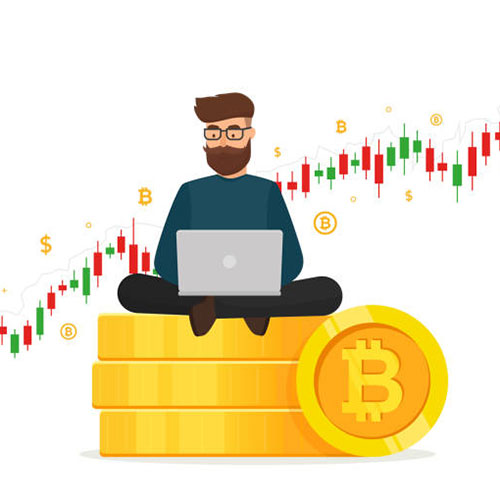The financial world is once again turning its eyes toward crypto and gold, as global uncertainty shakes traditional markets. During a conference in Riyadh on October 28, BlackRock CEO Larry Fink — the head of the world’s largest asset management firm — made a striking statement that immediately caught investors’ attention. He called gold and crypto “assets of fear,” explaining that people invest in them when they’re worried about debt, inflation, and currency debasement.
Fink’s comments come at a time when gold prices have fallen below $4,000, while Bitcoin continues to rally, reinforcing the idea of Bitcoin as digital gold. His remarks shed light on how fear and uncertainty are reshaping investment strategies worldwide.
Larry Fink’s Perspective: “Assets of Fear” in an Uncertain Economy
At the Riyadh conference, Fink stated,
“Owning crypto assets or gold are assets of fear. You own these assets because you’re frightened of the debasement of your assets. You’re worried about your financial security. You’re worried about your physical security.”
This statement perfectly captures the mood of global investors. In recent years, fears of currency debasement, rising debt, and geopolitical instability have driven a wave of investments into safe-haven assets.
Traditionally, gold has served as the go-to choice during crises. However, in recent years, cryptocurrencies like Bitcoin have begun sharing that role. With its limited supply and independence from government control, Bitcoin is increasingly viewed as a modern alternative to gold — particularly among younger, tech-savvy investors.
The Growing Fear of Currency Debasement
The idea of currency debasement is central to Fink’s message. It occurs when a government prints more money or takes on massive debt, reducing the value of its currency. As a result, people’s savings lose purchasing power over time.
Fink pointed out that investors are worried about the declining value of major currencies, including the U.S. dollar. He referred to this trend as part of the ongoing “debasement trade” — where investors sell government bonds and major currencies to buy gold, Bitcoin, and other scarce assets.
This shift reflects a deep loss of trust in traditional financial systems. As central banks continue to expand their balance sheets, and government debt reaches record highs, investors are looking for assets that cannot be manipulated or printed at will — which is where Bitcoin fits perfectly.
Gold’s Slump: The Safe Haven Losing Its Shine
Surprisingly, while Fink grouped gold and crypto together, gold has been under pressure. Prices have dropped 6% from record highs, now sitting at $3,957.79 per ounce. This decline has caught many market analysts off guard, considering that gold typically performs well during times of uncertainty.
There are a few possible reasons for this fall:
- Profit booking after gold’s record surge earlier this year.
- Strong performance by Bitcoin, attracting capital from gold investors.
- Stronger U.S. dollar movements in short-term trading cycles.
The decline in gold’s price has revived the digital vs. physical gold debate. Many now see Bitcoin as a more dynamic hedge — offering not only protection from inflation but also greater liquidity and growth potential.
As a result, investors are gradually shifting part of their “fear capital” from gold to crypto, fueling Bitcoin’s latest rally.
Bitcoin’s “Digital Gold” Narrative Gains Strength
Fink’s remarks are significant because they come from one of the most influential figures in global finance. For years, Bitcoin enthusiasts have promoted the idea that Bitcoin is digital gold — a store of value that’s immune to inflation and government interference.
Now, with BlackRock — the world’s largest asset manager — recognizing Bitcoin’s role alongside gold, that narrative has received powerful validation.
Bitcoin’s fixed supply of 21 million coins and decentralized nature make it appealing to those who fear economic instability. Unlike traditional currencies, Bitcoin cannot be inflated by government spending or central bank policies.
This is why many investors are using Bitcoin not just for speculation, but as a hedge against economic uncertainty — similar to how gold has been used for centuries.
The U.S. Debt Problem: A Hidden Catalyst for Fear
Fink also highlighted one of the biggest risks facing the global economy — America’s rising debt and dependency on foreign investment.
“We still are a nation that needs 30% to 35% of all our Treasury sales going overseas, and that’s the biggest issue today,” Fink said.
This means that the U.S. heavily depends on foreign investors to buy its Treasury bonds. If international confidence in U.S. debt declines, it could lead to massive sell-offs, a weaker dollar, and rising borrowing costs.
Such a scenario would likely push more investors toward safe-haven assets like gold and Bitcoin, accelerating the fear-driven movement that Fink described.
Why Fear Is the New Market Driver
Global markets today are dominated by emotions rather than fundamentals. Inflation, trade wars, political conflicts, and the risk of global recession have all contributed to investor anxiety.
Larry Fink’s remarks highlight how fear is now shaping investment behavior more than ever before. Investors aren’t just looking for profits — they’re seeking safety. They want assets that can withstand uncertainty and hold value even if the global financial system falters.
In this environment, Bitcoin and gold represent two sides of the same coin:
- Gold is the traditional safe haven.
- Bitcoin is the digital-age alternative for the same purpose.
But unlike gold, Bitcoin offers something more — portability, divisibility, and independence from governments. That makes it particularly attractive to a generation that values freedom, transparency, and technology-driven solutions.
Conclusion
Larry Fink’s statement that both gold and crypto are “assets of fear” perfectly captures the sentiment of the modern investor. With rising government debt, currency devaluation, and economic uncertainty, people are increasingly turning to assets that feel safe from central control.
While gold’s recent decline below $4,000 per ounce shows some cooling in traditional safe-haven demand, Bitcoin’s rising popularity signals that the market’s confidence is shifting.
As investors continue to seek protection from inflation and financial instability, the “digital gold” narrative of Bitcoin looks stronger than ever. Fear may be driving the markets, but for many, it’s leading them straight toward the crypto revolution.
FAQs
1. Why did Larry Fink refer to crypto and gold as “assets of fear”?
Larry Fink believes investors buy crypto and gold when they’re worried about losing money due to inflation or government policies. These assets act as safe havens during uncertain economic times, offering protection against financial instability.
2. Why is gold’s price falling despite economic uncertainty?
Gold has dipped below $4,000 due to short-term corrections and investors moving some of their funds into crypto assets like Bitcoin, which are showing higher growth potential. The shift reflects changing investor preferences rather than reduced fear.
3. What is meant by “currency debasement”?
Currency debasement happens when governments increase money supply or debt, reducing the value of their currency. As money loses purchasing power, investors buy assets like gold and Bitcoin to preserve value.
4. How does U.S. debt influence crypto and gold prices?
Rising U.S. debt makes investors nervous about the stability of the dollar and government bonds. This fear drives them toward assets that are not tied to government performance — such as gold and Bitcoin — boosting their demand and prices.
5. Is Bitcoin really replacing gold as a safe haven?
While gold remains a trusted store of value, Bitcoin is rapidly emerging as a digital alternative. Its limited supply and independence from central authorities make it appealing to investors seeking protection against inflation and economic uncertainty.













 Join Us
Join Us Follow Us
Follow Us









